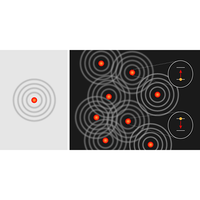Abstract
We report the observation of subradiance in dense ensembles of cold atoms operating near Dicke’s regime of a large number of atoms in a volume with dimensions smaller than the transition wavelength. We validate that the atom number is the only cooperativity parameter governing subradiance. We probe the dynamics in the many-body regime and support the picture that multiply excited subradiant states are built as a superposition of singly excited states that decay independently. Moreover, we implement an experimental procedure to release the excitation stored in the long-lived modes in a pulse of light. This technique is a first step towards the realization of tailored light storing based on subradiance.
4 More- Received 18 December 2020
- Accepted 3 March 2021
DOI:https://doi.org/10.1103/PhysRevX.11.021031
Published by the American Physical Society under the terms of the Creative Commons Attribution 4.0 International license. Further distribution of this work must maintain attribution to the author(s) and the published article’s title, journal citation, and DOI.
Published by the American Physical Society
Physics Subject Headings (PhySH)
 Viewpoint
Viewpoint
Finding Light in Dark Atomic Clouds
Published 10 May 2021
Researchers have prepared and manipulated subradiant states—in which collective effects slow down the decay of excited atoms—in a dense atomic cloud.
See more in Physics
Popular Summary
Interfaces between atoms and light are promising for quantum information protocols or metrology. When the atoms are close together, their influence on each other can produce collective interactions with the light field. A dramatic manifestation of this is “subradiance,” a strongly reduced emission rate of an excitation stored in a medium. This could be used to store and release light on demand, but the requirements for doing so are difficult to study. Here, we report the first observation of subradiance in a regime required for storing more than one photon.
Storage and release of light is possible when the distance between the atoms is smaller than the wavelength of the light and if the coupling between atoms can be controlled externally. This regime is very difficult to treat theoretically, making it challenging to understand subradiance beyond the regime where a single photon is stored in the ensemble. In our experiments, we trap an ensemble of ultracold rubidium atoms. By exciting the atoms with a resonant laser, we store light in subradiant excitations; we then use a second laser to switch off the interactions between the atoms and release the stored light.
These results provide an important benchmark for many-body theories and show that subradiance could provide an interesting path to tailored light-matter interfaces.




